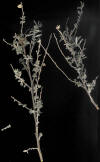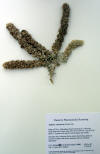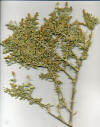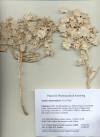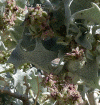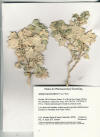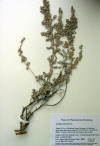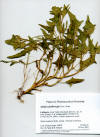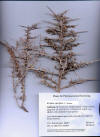|
Atriplex
acanthocarpa |
Atriplex
acanthocarpa |
Atriplex canescens var. macilenta Intricately branched rounded low shrub, ~30 cm high and in diameter. California, near margin of playa, Palen Lake, Sonoran Desert. CNPS Field-Based Rare Vegetation Sampling/Mapping Workshop in East Riverside County, February 5-6, 2011. Occurring with A. canescens var. canescenes, A. polycarpa, Ambrosia dumosa.
|
|
Atriplex canescens
|
Atriplex canescens
|
  
Atriplex canescens |
|
Atriplex canescens
|
Atriplex canescens |
Atriplex canescens
|
|
Atriplex canescens
|
Atriplex canescens
var. linearis
|
Atriplex canescens |
|
Atriplex confertifolia
|
Atriplex confertifolia
|
Atriplex corrugata
|
|
Atriplex elegans,
|
Atriplex gardneri var. cuneata Utah—Great Basin Desert. Wayne Co.: E of Caineville, Road 6650E, north off Hwy 24; 38º22'27.3", 110º53.51.9", 1420 m. Barren alkali lake with Atriplex and Oenothera along road margin. |
|
|
Atriplex hymenelytra,
|
Atriplex hymenelytra,
|
Atriplex julacea
|
|
Atriplex julacea
|
Atriplex
lentiformis
|
Atriplex
lentiformis |
|
Atriplex
obovata
|
||
|
Atriplex parryi
Near China Lake, CA |
Atriplex phyllostegia
|
|
|
Atriplex polycarpa
|
  Atriplex saccaria var. cornuta Utah, Great Basin Desert-Canyon Lands. San Juan Co., about 17 miles southwest of Blanding, 37º32'49.9", 119º35’38.1”, 1815 m. "Mancos Shale", white powdery gypsum soil; slopes with Atriplex; mesa with pinyon-juniper woodland.
|
Atriplex
spinifera |
|
Atriplex
spinifera |
Atriplex
spinifera
|
Atriplex torreyi |
|
Trees and Shrubs of Kern County (Sep 2012, Dec 2013) Atriplex. Salt brush (shrub species). Annuals, perennials, or shrubs. Shrub species often densely branched; leaves alternate (in the Kern County species), often clustered; flowering in the spring to summer but also in the autumn following precipitation after a dry spell; flowers mostly inconspicuous, males and females on separate plants (dioecious), no petals or sepals in female flowers, sepals in males. Fruit a diclesium (Spjut 1994), the utricular pericarpium covered by bracts. The species largely differentiated in the literature by characters of the fruit, which usually persists on the plants well into the fall; thus, male plants cannot be easily identified unless a female is nearby to help out! A comparison of fruits for A.. canescens, A. confertifolia, A. hymenelytra, A. parryi, and A. polycarpa is shown on Waynesword, http://waynesword.palomar.edu/domeland1.htm. In the Scandinavian region, Spjutmålla (meaning thorny bush) is a common name for several species of Atriplex. ~250 spp., widely distributed, 62 in the U.S. (Welsh, FNA), 8 shrub spp. in Kern Co.; 6 spp. used medicinally (Moerman); 113 extracts screened by the NCI before 1980, 1 active (Jan 1965) in Dunning leukemia ascites (Dl) from an extract of a fresh fruit sample of A. canescens collected Aug 1962 (CPAM 1977) from Cochise Co., AZ; 35 samples from 16 species collected in the U.S. for the NCI since 1996. 1. Leaves silvery white, holly-like. ..................................................... Atriplex hymenelytra 1. Leaves green, not conspicuously toothed along margins.................................................... 2 2. Leaves <4× longer than wide, oval, triangular, or elliptical......................................... 3
2. Leaves 4× or more longer than wide, with parallel
margins, or
3. Leaves about as
wide as long, or not more than 1.5× longer than wide,
3. Leaves distinctly
longer, often abruptly expanded near base (lobed);
4. Leaves heart-shaped, with a rounded notch at base that
surrounds
4. Leaves tapered to rounded or truncated at base; fruit
bracts larger, 5. Fruit with terminal flat wings, basally constricted to a spherical body....... Atriplex spinifera 5. Fruit round or fan-like from base, without constriction......................................................... 6 6. Plant spiny, stems ribbed..................................................................... Atriplex torreyi 6. Plants not spiny, stems not ribbed................................................. Atriplex lentiformis 7. Fruit with 4 irregularly rounded thin wings.............................................. Atriplex canescens 7. Fruit without wings, only knobby tubercles, or tooth-like indentations...... Atriplex polycarpa
Atriplex canescens (Calligonum canescens Pursh 1814) Nuttall 1818 var. canescens. Four-wing saltbush. Densely branched shrub, 1–2 m high; leaves persistent, usually narrow, blade-like to sickle-shaped, (3-) 5–10× longer than wide, up to 5 cm long, often folded or in-curved (longitudinally) along the midrib or margins so as to appear channeled; flowering May–Jun, and fall; fruit—diclesia with four kidney shaped to fan-shaped thin wings, 8–25 mm, notched at apex and base, scurfy or smooth except for varicose-like veins, entire to shallowly and irregularly toothed. Common on rocky substrates, often limestone soils, in deserts below 7,000 ft from Washington to Alberta (Canada), east to Kansas, and south to Mexico (Zacatecas, Sinaloa, and most of Baja California). Type from the plains of the Missouri, near Big Bend, SD. Fourwing saltbush scrub recognized in MCV2 when >2% absolute cover and >50% relative cover in the shrub canopy. Jepson (1909) in A Flora of California (Vol.1), Abrams (1944) in Illustrated Flora of the Pacific States (Vol. 2), and Welsh, Crompton and Clemants (2003) in Flora North America (Vol.4) distinguish Atriplex linearis from A. canescens as a species rather than as a subspecies (Shreeve & Wiggins, Vegetation and Flora of the Sonoran Desert, 1964, Vol.1) or variety (Munz in A California Flora, 1959; The Jepson Manual, 2nd ed. online). Shreeve and Wiggins recognized three subspecies and two varieties of A. canescens: Subsp. canescens, distinguished from subsp. linearis and subsp. macropoda by the wider leaves, "spatulate to oblong, usually over 3 mm wide" with several varieties, previously distinguished by Jepson, var. laciniata has fruits 4–10 m wide with dentate fruit wings (California from southern Mojave Desert to Salton Sea) and var. macilenta with smaller fruits (California: southern end of Salton Sea, type from near Calexico) with wings much reduced and appearing coarsely toothed, reportedly "not uncommon," and with an “aspect very different from the type”; var. laciniata, thought to be of hybrid origin between A. canescens and A. polycarpa, and reported by Welsh et al. to occur also in Nevada and Sonora, Mexico. Atriplex canescens var. gigantea S. L. Welsh & Stutz 1984 occurs on sand dunes in Utah (FNA 4, 2003). Subspecies macropoda, distinguished by shorter fruit wings than the terminal free part of the fruit, is endemic to Pinchilinque Island off the Gulf Coast of Baja California Sur, near La Paz. In sharp contrast, all of these subspecies and varieties, and more than 20 other named races, are all considered nothing more than "races" of a highly variable A. canescens (Sanderson & Stutz. 2001. Chromosomal races of Fourwing Saltbush (Atriplex canescens), Chenopodiaceae, USDA Forest Service Proceedings RMRS-P-21. 2001. http://www.fs.fed.us/rm/pubs/rmrs_p021/rmrs_p021_075_088.pdf). [Comment Feb 2011]. Kern Co.: Two or three varieties (of 4 in FNA): Var. canescens—the more common one (described above)—observed by Spjut as frequent along Hwy 14 between Mohave and Red Rock State Park, var. laciniata Parish 1914, distinguished by deeply incised fruit wings (JM2), collected by Twisselmann from sand dunes 1 mile west of Koehn Lake, 1,990 ft (CCH), type from Caleb, Colorado Desert (17 mi southeast of Indio, CA), and var. linearis (S. Watson 1889) Munz 1935, distinguished by narrow linear leaves ≤ 3 mm and irregularly toothed fruits, reported by Alison Sheehey in 2005 to occur in the Kern River Preserve (CalFlora). Twisselmann reported the species as “occasional” in the county; however, the species is common; CCH includes 18 records from desert slopes near Owen Peak region to Tehachapi Mts. and to Mt. Pinos at elevations from 600–1,900 m. Roots, leaves or flowers used medicinally by the Havasupal, Hopi, Isleta, Jemez, Navajo, Shoshoni and Zuni for treating ant bites, spider bites, swellings, rashes, toothache, and as an emetic (Moerman). Atriplex confertifolia (Obione confertifolia Torrey & Fremont 1845) S. Watson 1874. Shadscale. Generally a low densely branched shrub (<1 m), rounded in outline, branches ending in a sharp point (spine); leaves relatively smaller than in most other related shrub species, 1–2 cm, generally round (orbicular) in outline, most often gone by the summer; flowering spring and fall; fruits—diclesia persistent, straw to rose-colored, scattered to densely covering branchlets (female plants), with a small triangular basal body and larger expanded triangular to rounded wings, 4–12 mm, entire to toothed, the whole fruit having some resemblance to a butterfly. Largely in the Great Basin Desert, eastern Montana, Wyoming, Colorado, northern and western Texas, southeastern Arizona, up to 7,000 ft in California. Shadscale shrub recognized in MCV2 when dominant and >2% absolute cover. Type from borders of the Great Salt Lake. Kern Co.: CCH includes 16 records reported from the following locations: Southwestern end of Rogers Lake and Rosamond Lake on Edwards Air Force Base, Sheals near Rosamond, Cache Creek and adjacent areas near California City, near Kramer, Muroc, 5 miles southwest of Saddleback Mt, and from Red Rock Canyon, 602–1,220 m. Used medicinally by the Hopi, Navajo and Paiute. Plant smoked and inhaled for epilepsy, leaves boiled for muscle aches, leaf decoction taken to treat colds (Moerman). Atriplex hymenelytra (Obione hymenelytra Torrey 1857) S. Watson 1874. Desert holly. An easily recognized shrub by its silvery foliage and holly-like twisted leaves. Shrubs usually erect, < 40 cm but up to nearly 2 m in the Death Valley region; leaves broad, 1–1.5× longer than wide, 1.5–4.5 cm; flowering Feb–Apr; fruits—diclesia round to kidney-shaped, 7–10 mm, with prominent veins. Generally centered in the Mojave Desert, extending to southwestern Utah, western Arizona, and along the Gulf Coast of Baja California to Bahía de la Los Angeles. It seems most conspicuous in Death Valley where the landscape appears devoid of other shrubs and where the substrate is often red or black. Desert holly scrub recognized in MCV2 when dominant with >1% absolute cover. Type from hilly and gravelly places on the Williams River, AZ. Kern Co.: “Extensive colonies in the shadscale scrub in the low hills east and south of Ridgecrest through the El Paso Range” (Twisselmann), only three records in CCH, 793–838 m. “The plant is gathered in quantities at Christmas for the decorative use of its white holly-like leaves;” “such collections are illegal under Kern County Ordinance no 250” (Twisselmann). Atriplex lentiformis (Obione lentiformis Torrey 1874) S. Watson1874 [Includes A. breweri S. Watson 1874]. Quail bush. Shrub 1–2 high, with weak branches often tangled together and forming thickets to the extent that it is difficult to distinguish the separate plants; leaves arrow-shaped, 1.5–5 cm long; flowering spring and fall; flowers in a string-like clusters dangling from the main flowering stems; fruits—diclesia rounded in outline to wider in mid region, 3–4.5 mm. Common on alkali soils along streams such as the Colorado River, mostly below 2,000 ft in California to central Baja California, also southern Nevada, Utah and New Mexico. Quail bush scrub recognized in MCV2 when >50% relative cover in shrub canopy. Type from the lower Colorado River. Kern Co.: “Common in the Central Valley from Buena Vista Lake to Tulare Lake along sloughs, canals, and in waste places”, “occasional about the dry lakes on the desert and in waste places in South Fork Valley” (Twisselmann), 83–1,126 m (CCH). Used medicinally by Cahuilla and Pima. Leaves fresh, or dried and smoked, to treat colds; crushed flowers, stems and leaves steamed and inhaled for nasal congestion, powdered root applied to sores (Moerman). Leaves also consumed by Yuman tribes, but not before they have been boiled to reduce the salty taste. Atriplex parryi S. Watson. Parry's saltbush. A small rounded, intricately branched, spiny shrub, generally not more than 40 cm high and broad; young stems covered with white-powdery granules, older bark dark gray; branches slender, spiny at tip; leaves clustered and solitary, whitish green, covered with powdery dead glands, falling off by the summer, smaller ones triangular, larger ones heart-shaped or lobed at base, otherwise entire, 0.5–2 cm, clasping the stem, or attached to stem by a short petiole; flowering May–Jul; fruits wider than tall, kidney-shaped to fan-shaped, thick, rigid, 2.5–4 mm, smooth or with low tubercles. Mostly margins of saline valleys and lakes below 5,000 ft in the northern Mojave Desert to central Nevada. Type from Lancaster, CA. Kern Co.: CCH includes 6 records from the following locations: Edwards Air Force Base at southwest of Rogers Lake, Antelope Valley at Dry Lake, Desert Tortoise Research Natural Area, northeast of California City, southwest of Koehn Dry Lake, and 1/4 mile south of Rosamond (CCH). Not in Twisselmann or Moe. Atriplex polycarpa (Obione polycarpa Torrey 1857) S. Watson 1874. Allscale, common saltbush. Densely branched shrub to 2+ m high and 3 m broad; branchlets often short at right angles to a main branch, spiny at tips; leaves solitary and in clusters, deciduous in part, the solitary ones much longer and thinner than the clustered ones, narrowly elliptical, or slightly wider just below or above the mid region, 5–40+ mm long, flat or curled inwards along margins—U-shaped in x-section, up-curved along blade, the clustered leaves heart-shaped, short, thick, and folded lengthwise along midrib so as to appear V-shaped when viewed lengthwise, 1–3 mm; flowering Aug–Oct; flowers in round glomerules on terminal pinnately divided leafless branchlets that become successively shorter towards apex; fruits—diclesia inverse triangular to round, 1.5–3 mm. with short tentacles or nodular protuberances, or toothed, or rarely smooth. Perhaps the most common Atriplex in the California deserts, especially around dried alkali lakes below 5,000 ft, also in Utah, Arizona, northern Sonora and to southern Baja California (Mexico). Allscale scrub defined in MCV2 as >2% absolute cover and >50% relative cover in shrub canopy. Type from valley of the Gila River, AZ. Kern Co.: “A widespread and characteristic shrub of the Lower Sonoran grassland in the valley and the southern Temblor Range, where it often forms a scrub that covers hundreds of acres. It is also common on the lower desert plains from Mojave east to the San Bernardino County line and in Indian Wells Valley. Although it is often said to be the dominant plant in a climax association, it is actually rather weedy and seedlings are most abundant in heavily grazed lands, often after long periods of severe drouth [sic] when the wind has severely modified the soil. Immigrant annuals, especially grasses, that grow densely under common saltbush, have made the plant much more susceptible to fire damage than it was in primitive times. While the shrub is extremely xerophytic, even this sturdy inhabitant of the arid plains cannot stand prolonged drouth as is evidenced by the many dead plants on the low hills at Edwards Air Force Base and Near Boron” (Twisselmann), 64–1,189 m (CCH). CalPhotos shows a plant with branches mostly long and ascending to erect without right-angle branchlets and spines. This may possibly be a hybrid with A. canescens. The Maricopa and Pima tribes collected dried galls from the plant for relief of rheumatism, using a “moxa” of the galls burned on the affected area. For more about the galls, consult The ecology of the galls of Atriplex spp. (Chenopodiaceae) in southern California by B. A. Hawkins, University of California Press, 1984, 382 pp. Seeds also consumed as food, removed from the fruit bracts and pericarpia by pounding and then baked in a pit before eaten. Atriplex spinifera J. F. Macbride 1918. Spinescale. Densely branched shrub to 2+ m; branching nearly at right angles often in one plane, the branchlets straight to bent downwards; bark dark to pale gray, surface glazed with irregular short and narrow cracks, sloughing off and becoming narrowly furrowed with age; leaves deciduous, solitary and clustered, solitary ones scoop-shaped or spatulate and abruptly narrowed to a thick petiole, or in female plants with basal blunt to rounded lobes, the clustered leaves shorter and triangular in shape; flowers in small glomerules among clustered leaves of spine-tipped leafy branchlets; fruit—diclesia with a distinct basal spherical body and terminal entire to broadly toothed flattened wings, 7–15 mm. Alkali soils in the southern part of the valley to the western Mojave Desert, generally below 3,000 ft. Spinescale scrub recognized in MCV2 when “highest cover in the canopy has >50% relative cover in the shrub canopy.” Type from the Maricopa Hills of Kern County. Kern Co.: “Occasional, usually in sizeable colonies, in the valley and on the desert plains and sinks east of Mojave and Rosamond. It is especially common about Boron and on the subalkaline plains northeast of Lost Hills” (Twisselmann), 88–853 m (CCH). Male plants appear to have leaves shaped similar to Grayia spinosa, which its vegetative growth can be distinguished by the longitudinally white ridges on the stem separated by wider brown furrows. Atriplex torreyi (Obione torreyi S. Watson 1871) S. Watson 1874 var. torreyi. Torrey's saltbush. Large multi-stemmed shrubs, the stems ribbed, branches ending in a sharp spine-like point; triangular to broadly rounded above base, or slightly wider near mid region, ~3× longer than wide, 1.2–3.2 cm long, tapering abruptly to gradually to a short petiole 1–4 mm, apically rounded with a short mucro; fruit—diclesia fan-shaped, slightly broader than high, 1.3–4 mm, flattened and shallowly indented along edges. Margins of dry lakes in the Mojave Desert to southwestern Utah. Type from dry hills bordering the Truckee and Carson Rivers, NV. Kern Co.: “Bakersfield” (Jepson, Apr 1916), 4 mi east of the town of Mohave along Hwy 58, Dry Lake in Antelope Valley, and southwest corner of Beck Dry Lake on Edwards Air Force Base (CCH). The species can have sharply pointed branches despite the key distinction made in JM2 indicating that the species is not spiny. Welsh in FNA 2003 (Vol. 4) described the species as sometimes spiny. The species was formerly included under A. lentiformis (JM1), which differs by lack of lack of a well-defined trunk, not ribbed or striate, and by having long weak branches not ending in a sharp point. One other variety, A. torreyi var. griffithsii (Standley). G. D. Brown 1956, occurs in Cochise Co., Arizona (Welsh in FNA, 2003).
Biochemical Activity in Atriplex Mandak B. and S. Holmanova. 2004. The effect of fruit age on seed germinability of a heterocarpic species, Atriplex sagittata. Plant Biol. (Stuttg.) 6(6): 715–20. “Atriplex sagittata is an annual heterocarpic plant that produces three different fruit types (termed A, B, and C). To examine the consequence of heterocarpy on germinability patterns over long time periods, we compared seed germinability of different fruit types that had been stored for up to 8 years. While germinability of non-dormant type C fruits in distilled water was high (up to 100 %) in the first 2 years, it rapidly decreased over time. Dormant fruit types A and B showed increased germinability up to 7 years, though loss of germinability was lower for type B than for type A fruits. Eight-year-old fruits of all types had significantly lower germinability than younger fruits, probably due to loss of viability. Heterocarpy, therefore, ensures that emergence rates for seedlings of A. sagittata will be maintained over relatively long periods, even in years of strong disturbance when all adult plants may be destroyed. The experiment further showed that germinability of all fruit types in high concentrations of salt, as compared with water treatment, changed over the course of 8 years. Whilst dormant types (A and B) of A. sagittata show increased germinability with age of the seed in water treatment, they significantly lose germinability over time with salinity treatment. Type C fruit was not influenced by salt in the first year, but germinability rapidly decreased with time. It follows that the species is able to germinate under high salt concentration in the first year, but this advantage gradually disappears.” Olivera N., F. Sineriz and J. D. Breccia. 2005. Bacillus patagoniensis sp. nov., a novel alkalitolerant bacterium from the rhizosphere of Atriplex lampa in Patagonia, Argentina. Int. J. Syst. Evol. Microbiol. 55(Pt 1): 443–447. “A Gram-positive, rod-shaped, spore-forming bacterium (PAT 05T) was isolated from the rhizosphere of the perennial shrub Atriplex lampa in north-eastern Patagonia, Argentina. Its overall biochemical and physiological characteristics indicated that this strain should be placed in the alkaliphilic Bacillus group. Strain PAT 05T grew at pH 7-10 (optimum pH 8), but not at pH 6. Its DNA G+C content was 39.7 mol%. Sequence analysis of the 16S rRNA gene of PAT 05T revealed the closest match (99.6 % similarity) with Bacillus sp. DSM 8714. The highest level of DNA-DNA relatedness (88.6 %) was also found with this strain. On the basis of 16S rRNA gene sequence similarity and phylogenetic analysis, G+C content and DNA-DNA hybridization data, strain PAT 05T is related at the species level to Bacillus sp. DSM 8714, a member of a group referred as phenon 4a by Nielsen et al. [Nielsen, P., Fritze, D. & Priest, F. G. (1995). Microbiology 141, 1745-1761], which still lacks taxonomic standing. These results support the proposal of strain PAT 05T (=DSM 16117T=ATCC BAA-965T) as the type strain of Bacillus patagoniensis sp. nov.” |
||


